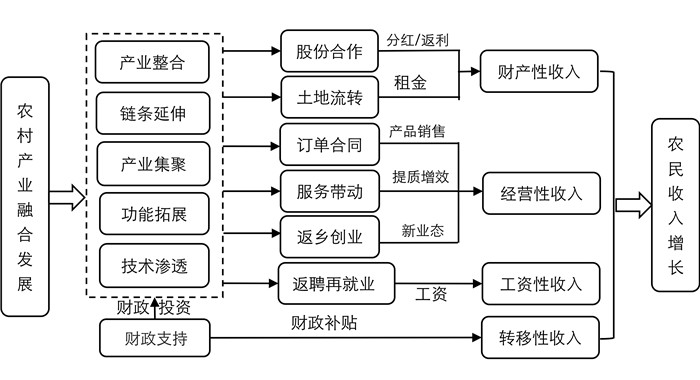全文HTML
-
促进农民持续增收是实施乡村振兴战略的重要目标之一,是中国全面建设小康社会和实现“中国梦”的应有之义。从2004年开始,伴随着中央一号文件持续聚焦“三农”问题,农民人均纯收入从2004年的2 936.4元快速跨越5 000元(2009年)和10 000元(2014年)大关,2019年已经上升到16 021元,实现了“十六连增”,年均增长率为11.75%。然而,在靓丽数据的背后也隐藏着一些不容忽视的问题,如何促进农民收入持续稳定增长仍是中国“三农”问题的重难点。一是农业长期粗放式经营模式受到“价格天花板”不断下压和“成本地板”不断抬升的双重挤压,以及农业生产价格补贴“黄线”不断逼近和资源环境“红灯”不断亮起的双重约束[1],农民家庭经营收入和转移性收入增长速度持续减缓且上升空间不断缩小。二是随着城镇化和工业化逐渐步入中后期,现代高新技术的不断推广和使用,以及受新常态下实体经济结构调整和增长动力转换等多重因素的影响,农民工尤其是文化程度偏低的农民工非农就业难度不断扩大,工资性收入增长难度及其对农民纯收入贡献率下降的风险显著增大。因此,促进农民收入持续增长必须在转变农业发展方式上寻求新突破,在扩宽农民增收渠道上开辟新途径。
2014年12月底,中央农村工作会议首次提出要大力发展农业产业化,把产业链、价值链等现代产业组织方式引入农业,促进农村一二三产业融合互动。2015年中央一号文件首次提出要推进农村一二三产业融合发展(以下简称“农村产业融合发展”),延长农业产业链、提高农业附加值,并表示农村产业融合发展是帮助农户增收的重要途径。2016年中央一号文件再次指出“推进农村一二三产业融合发展是拓宽农民增收渠道、构建现代农业产业体系的重要举措”。2017年中共十九大适时启动乡村振兴战略,要求促进农村一二三产业融合发展,支持和鼓励农民创业,让农民分享二三产业增值收益,拓宽农民增收渠道。显然,农村产业融合发展对促进农民增收具有重要的作用。但我们更关心的问题是:农村产业融合发展促进农民增收的作用机理如何?农村产业融合发展的增收效应是否具有区域异质性?如果有,其增收效应产生区域异质性的主要原因是什么?如何因势利导因地制宜完善并强化农村产业融合发展的增收路径?弄清楚这些问题不仅有助于加深对农村产业融合发展与农民收入关系的理解,还有助于为农村产业融合发展和乡村振兴战略的决策部门和实践部门提供理论参考和实践证据,具有重要的理论价值和现实意义。
归纳起来,当前关于农村产业融合发展与农民收入问题的已有研究集中体现在以下三个方面:一是农村产业融合发展及其相关问题。关于农业产业融合发展的观点,最早可以追溯到日本学者今村奈良臣所提出的“六次产业”概念[2],其认为六次产业=第一产业+第二产业+第三产业,后来为了强调产业融合又将其改为六次产业=第一产业×第二产业×第三产业。近年来,国内学者相关研究主要集中在农村产业融合发展的概念及内涵、融合模式与路径、目标与战略意义等[3-6],以及乡村振兴背景下农村产业融合发展的必然性和可行性[7],农村产业融合发展对乡村产业振兴的重要推动作用[8-9]。国外学者相关研究主要集中在日本六次产业化的发展状况[10]、韩国六次产业发展方向和路径[11]、利益联结机制[12]以及农业产业组织的形成及经济社会效应[13-14]等方面。二是农业产业化、农村产业融合发展与农民收入增长。闫磊等[15]研究发现农业产业化发展水平存在较大的区域差异,农业产业化发展对农民收入增长的影响作用先增后减。刘宇鹏和赵慧峰[16]基于“数据-行为-绩效”研究范式比较研究了不同农业产业化模式的经济效益,发现生态种养业产业化模式、生态农业与乡村旅游兼业产业化模式对农民收入增长具有显著促进作用。李乾等[17]从理论和实践双重视角论证了农村产业融合发展促进农民收入增长的路径和农民收入增长对农村产业融合发展的反馈互动。郭军等[18]利用河南省农村产业融合发展的典型案例研究了农村产业融合发展与农民收入增长的理论关系。基于微观调查数据,李云新等[19]发现农业产业融合发展能使农户家庭收入增长59%,杨晶和丁士军[20]研究发现融合组的户均总收入和经营性收入明显高于非融合组,农村产业融合发展有助于缩小低端和上端农户的收入差距。蔡洁等[21]发现参与农村产业融合对农民收入增长具有促进作用,而且农户非农就业能力的提高可以强化这种促进作用。从具体作用路径看,唐超和胡宜挺[22]基于北京的实证研究发现农村产业融合发展中农产品加工业主营收入、乡村旅游收入、设施农业收入等是促进农民收入增长的关键因素,李明贤和刘宸璠[23]发现农村产业融合发展中的农民专业合作社通过销售行为联结、服务型联结和租赁行为联结等渠道带动农民持续增收。李晓龙和冉光和[24]发现农村产业融合发展不仅可以对城乡收入差距产生直接的缩小效应,还可以通过影响农村经济增长和城镇化两个途径来产生间接效应。
毋庸置疑,以上广泛而深入的研究为本文提供了很好的理论借鉴与思路参考。但已有文献未能揭示农村产业融合发展促进农民收入增长的理论机理,也鲜有涉及农村产业融合发展增收效应及其区域异质性的实证研究,而且现有相关研究大多采用截面调查数据,没有考虑农村产业融合发展及其增收效应的动态演进性。与现有文献相比,本文可能的边际贡献在于:一是在梳理农村产业融合发展模式和利益联结机制的基础上,探讨了农村产业融合发展促进农民收入增长的逻辑关系和作用机理,并提出相应的研究假说; 二是目前尚未形成普遍认可的农村产业融合发展评价指标体系,本文基于中国2005-2018年31个省级行政区的面板数据,从农业产业链延伸、农业多功能性发挥和农业服务业融合三个维度构建农村产业融合发展评价指标体系,并综合采用熵值赋权法和欧式距离函数法测算了省际农村产业融合发展的综合指数; 三是本文利用动态面板模型、面板门槛模型等计量分析方法,全面考察了农村产业融合发展及其分指数对农民人均纯收入、工资性收入、家庭经营收入、转移性收入、财产性收入和非农收入增长的影响效应和区域差异性。
-
目前,在农村产业融合发展过程中主要呈现出了农业产业整合、农业产业链延伸、农业多功能拓展、技术渗透和农业产业集聚等几种融合模式。农业产业整合型融合模式主要以农业优势资源为基础,以涉农经济组织为主体,以农牧结合、农林结合、循环发展为导向,调整优化农业种植养殖结构,实现农业内部紧密协作和循环发展。农业产业链延伸型融合模式是以某一涉农企业为核心,以生产、加工或销售为关键环节,将单一农业产业向产前产后纵向延伸,形成一条龙发展的“全产业链”,增加农产品附加值。农业功能拓展型融合模式是在稳定传统农业的基础上,重点开发农业多种功能,促进农业与旅游、教育、文化、健康等产业融合,培育休闲农业、旅游农业、文化农业、创意农业等新业态。技术渗透型融合模式是在农业生产经营领域引入互联网、物联网、云计算、大数据等现代信息技术,实现农业生产、加工、管理、运输、销售等各个环节无缝对接,推进农业产业升级。农业产业集聚型融合模式以农业产业化龙头企业或产业链中的核心企业为依托,促进农业企业集聚发展,打造出集生产加工、仓储物流、商务会展、休闲娱乐、生态旅游等于一体的复合型农业综合体。
归纳起来,农村产业融合发展促进农民收入增长主要通过不同的融合模式和相应的利益联结机制来增加农民家庭经营收入、工资性收入、转移性收入或财产性收入,从而带动农民人均纯收入的增长,其内在逻辑关系和作用机理如图 1所示。
一方面,在推进农村产业融合发展的过程中,农民可以将自己所承包的零散土地流转给农业产业化龙头企业,企业对流转来的土地进行统一规划和布局,然后将土地使用权承包给适度规模经营的新型农业经营主体,转出土地的农民可以获得租金收入并同时拥有新型农业经营主体的优先受雇(返聘)权从而获取稳定的工资性收入。当然,农民可以以土地、房屋、机械设备、资金、劳务等向企业入股,或企业以资金、技术、品牌、机械设备等入股牵头设立农民专业合作社,企业与农户之间建立“权益共享、风险共担、互惠共赢”的合作关系,农民通过“保底收益+按股分红”“按股分红+二次返利”“保底收益+利润分成”等多种方式获得稳定的分红收益或利润分成。另一方面,随着农业产业链的不断延伸,农业企业或农民专业合作社和农民之间可以签订合同,农业企业按照约定的价格(一般为协议保护价或市场价的一定涨幅)、数量和质量向农户收购农产品[17],同时农业企业或农民专业合作社根据农户实践需要提供资金扶持、技术指导、农产品代销包销等特色服务,提高农户生产效率和农产品质量,通过“企业+基地+农户”或“公司+合作社+基地+农户”等模式带动农民增收。同时,随着农村产业融合发展的不断推进,以及国家创新创业政策的引导,农业经济、文化、生态、旅游等多种功能不断拓展,越来越多的进城“能人”将返乡创业,当然也有部分城镇资本下乡创业,新产业、新业态、新模式不断涌现,农业价值创造能力不断提升[25],农业产业结构不断优化,农村产业规模和农村就业容量不断扩大,农村土地、住宅、金融、劳动等市场也随着逐渐活跃,扩宽了农民增收渠道。另外,在乡村振兴战略和脱贫攻坚背景下,各级政府出台了一系列关于农村产业融合发展的支持政策,包括加快完善农村基础设施建设,加大新型农业教育主体的财政补贴力度和广度等,农村生产生活的外部环境日益改善,贫困农户家庭的转移性收入稳步增长。
综上,本文提出待检验的假说1:
农村产业融合发展可以通过不同途径增加农民家庭经营收入、财产性收入、工资性收入和转移性收入,进而促进农民人均纯收入持续增长。
-
必须指出的是,一般情况下,农村产业融合发展水平越高,经营主体之间的利益联结越紧密,农民从中所获得的农业增值收益越多,家庭人均纯收入增长就越快。因此,农村产业融合发展对农民收入增长的影响作用可能会因为农村产业融合发展水平的高低而在省际或区域层面呈现出非均衡特征,即区域异质性。然而,农村产业融合发展是一项长期性、系统性、动态性的复杂工程,目前尚处于试点探索阶段,其发展水平的高低受外部环境和支撑条件(包括农村经济基础、财政金融支农政策、农村人力资本水平、农村基础设施建设等多种因素)的共同影响,不同省市之间农业产业经济基础、外部环境和资源禀赋的差异也将导致农村产业融合发展水平出现明显的省际差异。农村经济发展水平在一定程度上决定着农业生产的原始积累,农村基础设施建设和农业生产资源要素禀赋在一定程度上决定着农业生产方式和生产规模,农村财政金融服务水平和质量在一定程度上决定着农村新型农业经营主体的成长速度,因此在农村经济发展水平高、基础设施建设完善、农业资源要素禀赋丰富、财政金融服务完善的省市,新产业新业态发展的基础越雄厚,新型农业经营主体成长速度越快,农村产业融合发展水平就越高。农村劳动力受教育程度越高,接受和掌握新技术、新知识、新方法的能力越强,农业产业整合、农业产业链延伸、农业技术渗透越容易,农村产业融合发展越快越好。
综上,本文提出待检验的假说2:
农村产业融合发展的收入效应因外部环境和支撑条件的差异而存在明显的区域异质性。
一. 农村产业融合发展促进农民收入增长的作用机理
二. 农村产业融合发展收入效应的区域异质性
-
本文借鉴现有大多数文献[26-27]的做法,采用“农民人均纯收入”来衡量农民收入增长情况。根据《中国统计年鉴》中主要统计指标解释可知,农民人均纯收入是指农村住户当年从各个来源得到的总收入扣除所发生费用后的收入总和。按照收入的来源,农民人均纯收入可以分为工资性收入、家庭经营收入、财产性收入和转移性收入四大类。其中工资性收入、财产性收入和转移性收入可以统称为非农收入[28]。用NI、OI、WI、CI、TI、NFI分别表示农民人均纯收入、家庭经营收入、工资性收入、财产性收入、转移性收入和非农收入。
-
关于农村产业融合发展的评价,目前学术界主要采用构建综合指标体系进而测算综合指数的方法来衡量[29-31],但不同学者基于不同研究目的而设计的指标体系也不尽相同,目前尚未形成一套普遍认可的农村产业融合发展的评价指标体系。综合政府相关文件和已有文献可以发现,农村产业融合发展是以农业为基础,通过农业产业链延伸、农业多功能拓展、农业生产要素集聚和农业服务融合等方式推动农村一二三产业有机整合、紧密相连和相互促进,从而将更多的增值收益留在农村留给农民[5, 32]。因此,其评价指标体系主要包括农业产业链延伸、农业多功能性发挥、农业服务业融合发展等几个维度。本文旨在研究农村产业融合发展对促进农民收入增长的影响效应,考虑到数据的可获得性和指标的可比性等基本原则,将从农业产业链延伸、农业多功能性发挥、农业服务业融合发展三个维度构建农村产业融合发展综合评价指标体系,具体指标体系如下表 1。农副产品加工业总产值采用规模以上农副产品加工业总产值代替,原始数据来源于历年各省市统计年鉴。人均主要农产品产量采用粮食、棉花、油料、猪牛羊肉、水产品、牛奶的人均产量加总得到,农林牧渔服务业总产值采用农林牧渔业总产值与第一产业产值之差进行衡量①,原始数据来源于历年《中国统计年鉴》。现有统计资料中缺乏2013-2014年农村平均每百户拥有电话和计算机的数量,本文采用前后相邻2年的数值近似计算得到,具体的计算公式为:2013年值=2012年值×2-2011年值; 2014年值=2015年值×2-2016年值。其他未作说明的指标都可以从历年《中国统计年鉴》和《中国农村统计年鉴》获取原始数据。
① 根据历年统计年鉴中的主要统计指标解释说明,第一产业指农业、林业、畜牧业和渔业,不包含农林牧渔服务业,而农林牧渔业总产值则包括了农林牧渔服务业产值。
根据表 1中的指标体系,本文首先采用最大最小值法对原始数据进行无量纲化处理,同时对标准化值进行平移处理以克服无量纲化处理后“0”值对计算结果的影响,相应的计算公式为:
上式中,Sij为标准化值,且Sij取值为[1, 2],其值越大表示该指标对农村产业融合发展综合指数的贡献度越大。Xij为实际值,m和n分别表示样本数和指标数,i=1,2,…,m; j=1,2,…,n。max(Xj)和Min(Xj)分别表示当年31个样本中第j个指标最大值和最小值。标准化处理以后需要确定各指标的权重大小,一方面可以以此来表征各指标对农村产业融合发展综合指数的贡献度,另一方面又为测算综合指数奠定基础。目前关于指标权重的确定方法主要包括主观赋权法和客观赋权法,主观赋权法难免存在一定的主观偏见,客观赋权法又容易导致确定的指标权重与属性的实际重要程度相悖的现象。因此,本文采用主客观权重综合赋权法予以克服,计算公式为:综合权重=主观权重×0.5+客观权重×0.5。主观权重采用层次分析方法(AHP)来确定,客观权重采取熵值赋权法来确定。限于篇幅,层次分析法和熵值赋权法的计算过程和公式不再赘述。然后,采用欧式距离函数法计算各省份各年的农村产业融合发展综合指数RICD及三个分指数(农业产业链延伸RICE、农业多功能性发挥RMP和农业服务业融合发展RSC)。RICD计算公式为(分指数的计算原理和公式与之相似,不再赘述):
其中,λ表示指标权重,S表示指标标准化值。RICD的值越大表示农村产业融合发展水平越高。
-
为了剔除其他因素对结果的影响,本文将重要的其他影响因素作为控制变量纳入计量模型。考虑到农村经济发展水平主要影响农民家庭经营收入,而城市经济发展水平也可以影响农民外出务工收入,因此本文采用人均国内生产总值而非人均农林牧渔总产值来衡量经济发展水平(GDP),计算公式为:GDP=国内生产总值/总人口,并取对数处理。鉴于中国农村信贷的实际情况,可能农户贷款与农民收入增长之间的关系更为密切,但现有统计资料中不能获取2015-2018年各省市的农户贷款的所有数据,因此本文采用各省农林牧渔业贷款与农林牧渔业总产值之比来衡量农业信贷(RCL)。农业保险(RINS)采用各省农业保险深度,即农业保险保费收入与农林牧渔总产值之比来衡量。农业保险的主要目的就是当农业生产经营者因保险事故发生导致收入减少时,保险公司提供经济补偿以保障农民收入。因此农业保险深度越大,农业保险对农民收入增长的影响作用越大。财政支农(RFIS)采用各省财政支农强度,即财政支农支出与农林牧渔总产值之比来衡量。农村人力资本(RHC)采用农村6岁及以上人口平均受教育年限的对数来衡量①。一般情况下,农民受教育程度越高,掌握农业生产新设备和新技术的能力越强,其劳动生产效率越高,既可以增加农户家庭经营收入,又有助于农民增加外出务工时间,而且文化程度越高,劳动力的平均工资水平也越高,可以获取更多的工资性收入。用primary、junior、senior和college分别表示小学、初中、高中和大专及以上教育程度的农村人口占比,农村人口平均受教育年限的基本计算公式为RH=6×primary+12×junior+12×senior+16×college,相关数据来源于历年《中国人口和就业统计年鉴》。
① 理论上,采用农村劳动力的平均受教育年限来衡量农村人力资本水平可能更加准确,但现有统计资料中仅能找到2005-2013年的农村劳动力平均受教育年限,因此本文采用农村6岁及以上人口平均受教育年限来衡量。
-
为考察农村产业融合发展对农民收入增长的影响效应和作用路径,设定如下动态面板数据模型:
其中,Y表示农民收入增长,包括农民人均纯收入、家庭经营收入、工资性收入、财产性收入、转移性收入和非农收入。RICD表示农村产业融合发展(Rural Industrial Convergence Development),RICE、RMP、RSC分别表示农村产业融合发展的分指数农业产业链延伸、农业多功能性发挥和农业服务业融合发展,X为一系列影响农民收入增长的其他因素。μi表示不随时间变化的各省市截面的个体差异,εit为随机扰动项。针对以上动态面板数据模型,本文同时采用差分GMM和系统GMM方法估计并进行结果比较,但限于篇幅本文仅列举系统GMM的估计结果。本文采用“杜宾-吴-豪斯曼检验”方法考察模型的内生性问题,并采用工具变量识别不足LR统计量检验和过度识别Hansen's J统计量检验来筛选工具变量。
在此基础上,为了进一步考察农村产业融合发展收入效应的区域异质性,本文建立以下面板门槛回归模型:
其中,Y仍为农民人均纯收入。qit为门槛变量,即影响农村产业融合发展促进农民增收的主要因素,γ为需要确定的门槛值; I(·)为示性函数,当括号内的表达式为真时取值为1,反之为0;Ricd表示农村产业融合发展水平; Xkit为其他控制变量集合,αk为相应的待估系数; λi为固定效应,εit为随机扰动项。在单门槛模型基础上可以扩展成双门槛模型甚至多门槛模型。
-
鉴于中央一号文件从2004年开始一直聚焦于“三农”问题,同时考虑数据的可得性和可比性,本文研究对象包括中国31个省级行政区,时间跨度为2005-2018年。农村产业融合发展各指标数据来源于历年《中国统计年鉴》和《中国农村统计年鉴》,收入相关数据来源于历年《中国统计年鉴》及各省市历年统计年鉴,农业信贷和农业保险的数据主要来源于历年《中国金融年鉴》《中国保险年鉴》和ESPN、Wind数据库,各省市总人口、人均GDP、财政支农支出、农村人口受教育程度的原始数据来源于历年《中国统计年鉴》《中国人口和就业统计年鉴》。为了消除通货膨胀因素的影响,本文采用GDP平减指数对所有与价格有关的数据以2005年为基期进行处理。同时,对农民人均纯收入、农民家庭经营收入等非比值型变量取对数处理,以减轻异方差对结果的影响。经过处理后各指标数据的全国、东部、中部和西部均值和标准差统计结果如下表 2所示。
为了保证实证研究结果的可信性,本文对各数据进行平稳性检验,检验结果如下表 3所示。LLC检验结果显示绝大多数指标都通过显著性检验,拒绝面板包含同质单位根的原假设; PP-Fisher检验结果中有部分指标没有通过显著性检验,无法拒绝面板包含异质单位根的原假设。但无论是全国还是分东中西部地区,任何一个指标都至少通过LLC检验或PP-Fisher检验,因此根据综合判断的原则,可以判断所有指标的数据都是平稳的,可以进行回归估计。
一. 指标选择
1. 被解释变量:农民收入增长
2. 解释变量:农村产业融合发展
3. 控制变量
二. 模型设定
三. 数据说明
-
首先利用方程(3)和方程(4)来考察农村产业融合发展的收入效应及实现途径,也即检验研究假说1。首先检验全样本下农村产业融合发展的收入效应,检验结果如下表 4所示,模型1-模型6分别显示了农村产业融合发展对农户家庭人均纯收入、家庭经营收入、工资性收入、财产性收入、转移性收入和非农收入的影响效应。
从表中结果可以看出,6个模型的显著性、自相关AR(2)检验、工具变量有效性Sargan检验全部通过,说明计量模型设定是合理的,结果是可信的。农村产业融合发展(RICD)的回归系数在模型1、模型2、模型3和模型6中通过显著性检验,这说明农村产业融合发展对农民人均纯收入具有显著的正向作用,目前这种正向作用主要通过促进家庭经营收入和工资性收入增长而实现。在模型1、模型2、模型3和模型6中,农村产业融合发展(RICD)的回归系数分别为0.346 1、0.247 6、0.233 1和0.391 2,均在1%水平下通过显著性检验,说明农村产业融合发展水平每上升1个标准差,农户家庭人均纯收入、家庭经营收入、工资性收入、非农收入分别将提升34.61%、24.76%、23.31%和39.12%。在模型4中,农村产业融合发展(RICD)的回归系数为0.136 0,不显著,这说明农村产业融合发展当前处于试点初期,对农户家庭财产性收入的影响效应不明显。在模型5中,农村产业融合发展(RICD)的回归系数为0.278 3,不显著,可能的原因是在农村产业融合发展的试点过程中,政府财政涉农资金整合以后更多是通过产业融合项目发放,而并非直接补贴到农户家庭中,原有的部分直接发放的财政补贴资金也在减少,进而导致农民家庭转移性收入的增长变化并不明显。
控制变量中,经济发展水平(GDP)和农业信贷(RCL)的回归系数全部显著为正(模型5中RCL的系数不显著除外),说明经济发展水平和农业信贷对农户家庭收入增长具有重要的促进作用。经济发展水平越高,农民就业创业的机会越多,城镇居民下乡消费和投资越多,农民增收渠道越宽,收入增长越快。农业信贷的不断增加可以有效解决农户家庭经营和创业过程中的资金短缺问题,有助于促进农民家庭经营收入不断增长,同时农村居民创业项目成功越多,所提供的就业岗位也会带动周边群众的工资性收入增长。农业保险(RINS)的系数在模型1、模型2、模型5和模型6中显著为正,在模型3和模型4中为正但不显著。当前,农业保险产品主要包括产量保险、目标价格保险和收入保险等几种主要类型,这些保险产品尤其是收入保险有助于分散农业生产经营过程中的自然风险和市场风险,为农户家庭收入增长提供了重要的保障作用。理论上,财政支农对促进农民收入增长具有重要作用,而且这也是国家多项支农政策的重要依据,但本文实证检验结果中财政支农(RFIS)的回归系数在模型1和模型4中显著为正,在模型2、模型3、模型5和模型6中显著为负,即农村产业融合发展试点过程中,财政支农支出有助于促进农民人均纯收入和财产性收入增长,但对家庭经营收入、工资性收入、转移性收入和非农收入增长具有一定的负效应,可能的原因是当前政府正在试点财政涉农资金整合,对原有财政涉农资金的投放方式进行了调整和创新,从而对农民收入增长结构尤其是转移性收入占比产生了重要影响。农村人力资本(RHC)在模型1、模型3和模型6中显著为正,在其他3个模型中不显著。这说明农村劳动力受教育年限的高低对农民收入增长具有重要的影响作用,但主要是通过影响工资性收入发挥作用。这基本符合农村现实,农业生产更多属于劳动密集型劳动,农民受教育程度的高低对农业生产的影响并不大,因此农村人力资本水平对农民家庭经营收入的影响不显著,但在城镇化和工业化进程中,农村有知识、有技术的劳动力大量外出务工,而且拥有某些专业技术的农村劳动力进城务工的工资水平更高,工资性收入逐渐成为他们的主要收入来源,从而使得农村人力资本水平对农民工资性收入产生重要影响。
进一步,本文将利用方程(4)来考察农村产业融合发展各分指数的收入效应。前面分析表明,农村产业融合发展主要通过促进农民家庭经营收入和工资性收入增长来促进人均纯收入增长,因此本部分将首先检验各分指数对人均纯收入、家庭经营收入、工资性收入和非农收入的影响效应,检验结果如下表 5所示。模型的Wald检验、自相关AR(2)检验和工具变量有效性Sargan检验都表明模型设定是合理的。从表 5中的结果可以看出,农业产业链延伸(RICE)、农业多功能性发挥(RMP)和农业服务业融合发展(RSC)三个分指数的回归系数在所有模型中全部显著为正,说明农业产业链延伸、农业多功能性发挥和农业服务业融合发展都对农民人均纯收入、家庭经营收入、工资性收入和非农收入增长具有正向作用,农村产业融合发展对农民收入增长的促进作用是各分指数共同作用的结果。比较各分指数的回归系数大小可以发现,农业多功能性发挥对农民人均纯收入和家庭经营收入的促进作用最大,尤其是在促进农民家庭经营收入增长的过程中,农业多功能性发挥的正效应相比农业产业链延伸和农业服务业融合发展的优势比较明显。在促进农民工资性收入的增长过程中,农业服务业融合发展的正效应略高于农业多功能性发挥,二者明显优于农业产业链延伸。在促进农民非农收入增长的过程中,农业服务业融合发展的正效应最高,农业多功能性发挥的正效应次之,农业产业链延伸的正效应最小。
为了探索农村产业融合发展对农民财产性收入和转移性收入影响效应不显著的原因,本文也进一步分析各分指数对农民财产性收入和转移性收入的影响作用,检验结果如下表 6所示。从表 6中结果可以看出,尽管农业产业链延伸对农民财产性收入增长具有弱正效应(系数为0.066 0,在5%的水平下显著),但农业多功能性发挥和农业服务业融合发展对农民财产性收入增长的作用不显著,而且农业多功能性发挥的回归系数为负,三者相互影响导致农村产业融合发展对农民财产性收入增长的正效应不明显(表 4中其回归系数为0.136 0,不显著)。农业服务业融合发展对农民转移性收入的影响效应显著为负(回归系数为-0.218 3,在5%的水平下通过检验),农业产业链延伸和农业多功能性发挥对农民转移性收入的正向效应不显著,三者共同作用导致农村产业融合发展对农民转移性收入的总效应不显著(表 4中其回归系数为0.278 3,不显著)。可见,农村产业融合发展对农民财产性收入和转移性收入的影响效应不显著是三个分指数相互作用的结果,在实践过程中要提升农村产业融合发展的收入效应,不仅需要不断提升农村产业融合发展水平,更需要加强各分指数之间的协调与互动。
-
本文将全样本分成东部、中部、西部、试点省和非试点省5个子样本来考察农村产业融合发展对农民人均纯收入影响效应的区域差异性,检验结果如表 7所示。结果显示,农村产业融合发展(RICD)的回归系数在中部、试点省和非试点省3个样本下显著为正,在东部、西部地区不显著; 农业产业链延伸(RICE)的回归系数在中部、西部、试点省和非试点省4个样本下显著为正,在东部地区不显著; 农业多功能性发挥(RMP)的回归系数在中部、试点省和非试点省3个样本下显著为正,在东部和西部地区不显著; 农业服务业融合发展(RSC)的回归系数在东部、试点省和非试点省3个样本下显著为正,在中部和西部地区不显著。这说明在控制其他因素的情况下,农村产业融合发展的收入效应存在明显的区域异质性。
以上分析表明,农村产业融合发展有助于促进农民收入增长,但这种正效应明显存在区域异质性。那么,导致农村产业融合发展收入效应出现区域异质性的根本原因是什么?正如理论分析所述,一方面,农村产业融合发展促进农民收入增长可能存在一个基于自身发展水平的门槛效应,当农村产业融合发展水平低于某一临界值时其收入效应不显著甚至显著为负,当农村产业融合发展水平超过某一临界值以后则显著为正。另一方面,农村产业融合发展促进农民收入增长有赖于良好的外部环境和完善的支撑条件,各地区外部环境和支撑条件的差异将导致农村产业融合发展的收入效应出现区域异质性。
接下来,本文将利用方程(5)来实证研究农村产业融合发展收入效应的异质性原因。首先以农村产业融合发展水平(RICD)自身为门槛变量来检验第一种可能,以农村经济发展水平(以农林牧渔总产值衡量,用AGDP表示)、农村金融服务(以农林牧渔业贷款和农业保险深度衡量,用ADK和RINS表示)、农村人力资本水平(以6岁以上人口平均受教育年限衡量,用RHC表示)和农村基础设施建设(以农户固定资产投资额衡量,用RGT表示)为门槛变量来检验第二种可能。
首先是门槛效应检验。采用自抽样法(Bootstrap)检验门槛模型的具体形式。检验结果如下表 8所示,限于篇幅,仅列举通过检验的结果。从结果可知,以农村产业融合发展(RICD)、农村基础设施建设(RGT)为门槛变量的模型均通过了单门槛效应检验,而以农村经济发展水平(AGDP)和农业保险深度(RINS)为门槛变量的模型均通过了双门槛效应检验; 以农林牧渔业贷款(ADK)和农村人力资本水平(RHC)为门槛变量的模型没有通过检验。在金融总体处于抑制状态的农业农村领域,金融支持对农村产业融合发展具有重要作用,但实践中金融支持不足是农村产业融合发展的最大短板,金融支持农村产业融合发展必须加强财政资金的引导和社会资本的配合[33-35]。其次是门槛值估计。从表 8中的结果可以看出,各模型门槛值都位于95%置信区间内,表明模型的门槛值与实际门槛值相等,即模型估计出的门槛值是有效的。
以农村产业融合发展自身为门槛变量的估计结果见表 9中的模型Ⅰ。当农村产业融合发展水平低于门槛值0.424 9时,其回归系数为0.022 1,且在1%水平下显著,当农村产业融合发展水平跨越门槛值以后,其回归系数上升为0.210 6,且在5%水平显著。这说明农村产业融合发展的收入效应在不同的发展阶段具有差异性,随着农村产业融合发展水平的不断提升,其对农民收入增长的促进作用将不断增强,农村产业融合发展水平越高,其对农民收入增长的促进作用越大。该结论证明,加快推进农村产业融合发展对解决农民收入增长难题具有重要的战略意义。
以农村经济发展水平(AGDP)、农业保险深度(RINS)和农村基础设施建设(RGT)为门槛变量的估计结果分别见模型Ⅱ-模型Ⅳ。当农村经济发展水平和农业保险深度分别低于第一个门槛值7.235 4和0.255 9时,农村产业融合发展对农民收入增长的影响效应显著为负(回归系数分别为-0.643 0和-0.631 5,均在1%水平下显著),当跨越第一个门槛值以后,农村产业融合发展对农民收入增长的影响效应转为正(回归系数分别为0.073 6和0.357 1),但不显著,当跨越第二个门槛值8.340 0和0.271 7以后,农村产业融合发展对农民收入增长的影响效应显著为正,而且这种正向作用不断增强(回归系数分别为0.093 1和0.376 5,略有上升)。当农村基础设施建设水平低于门槛值5.025 0时,农村产业融合发展对农民收入增长的影响效应显著为负(回归系数为-0.523 4,在5%水平下显著),当农村基础设施建设超过门槛值以后,农村产业融合发展对农民收入增长的影响效应显著为正(回归系数为0.203 3,在10%水平下显著)。以上结果表明,农村产业融合发展对农民收入增长的作用效应受农村经济发展水平、农业保险深度和农村基础设施建设水平等外部环境或支撑条件的影响,农村产业融合发展促进农民收入增长需要有良好的外部环境和完善的支撑条件作为保障,不同省市之间农村外部环境和产业发展支撑条件的差异决定了农村产业融合发展收入效应的区域差异。
综上结果表明,农村产业融合发展收入效应的实现存在基于自身发展水平、农村经济发展水平、农业保险深度和农村基础设施建设的门槛效应,当各门槛变量跨越相应的门槛值以后,农村产业融合发展对农民收入增长的影响效应将不断增强。因此,要充分发挥农村产业融合发展的收入效应,一方面需要加快推进农村产业融合发展试点和复制推广,不断提升农村产业融合发展水平,另一方面也需要营造良好的农村产业发展外部环境,不断完善农村产业融合发展的支撑条件,为农村产业融合发展及其收入效应的实现夯实基础。
-
首先,本文采用准自然实验方法,以农村产业融合发展试点省①作为实验组,其他非试点省作为对照组,以2015年为政策冲击时间点,采用双重差分(DID)计量方法来检验试点政策对农村产业融合发展收入效应的影响作用。建立如下计量模型:
① 2016年上半年全国确立了12个农村产业融合发展示范省,具体包括重庆、安徽、江苏、湖南、山东、辽宁、黑龙江、浙江、江西、河南、湖北、贵州。
其中,Y表示农民人均纯收入,SD表示是否进行农村产业融合发展试点示范的地区虚拟变量。SD=1时为处理组,表示该省市是农村产业融合发展试点省; SD=0时为控制组,表示该省市不是农村产业融合发展试点省。Time表示时间虚拟变量,2015年之前年份为0,2015年及以后年份为1;X为一系列控制变量。
表 10显示了政策效应的检验结果。以表 10中第一列回归结果(以人均纯收入NI为被解释变量)为例,在控制其他影响因素的情况下,SD的回归系数为0.000 9,在1%的水平下显著,这说明在不控制时间点的情况下,实验组农民人均纯收入要明显高于对照组农民人均纯收入。Time的回归系数为0.006 7,在1%的水平下显著,说明开始试点农村产业融合发展以后,无论是实验组还是对照组的农民人均纯收入都有显著提高。但是这两个系数都不能完全准确地反映农村产业融合发展试点给农民收入增长带来的净效应。我们重点关注倍差法估计量SD×Time,其系数在所有模型中显著为正,且至少通过5%的显著性水平检验,这说明在控制了时间效应和差异效应的情况下,农村产业融合发展对农民收入增长具有显著正效应,即与对照组相比,农村产业融合发展试点以后实验组农民人均纯收入得到了显著提高。
此外,本文还做了以下三个方面的稳健性检验:(1)重新计算农村产业融合发展综合指数。一是分别采用主成份分析法和熵值赋权法来计算各指标的权重,然后仍采用欧式距离函数法计算农村产业融合发展的综合指数; 二是仍采用主客观综合赋权法计算各指标的权重,然后采用线性加权求和法重新计算农村产业融合发展的综合指数。结果发现,两种方法计算出来的农村产业融合发展综合指数和分指数虽然在具体数值上有细微差异,但不改变农村产业融合发展综合指数和分指数的动态变化趋势及区域特征,收入效应及其异质性的检验结果也无实质性改变。(2)替换被解释变量和控制变量的衡量指标。一是分别采用各项收入的年增长率来衡量农民收入增长情况; 二是农业保险采用各省市农业保险广度,即农业保险保费收入与农业人口之比来衡量; 财政支农采用人均财政支农支出来衡量,并取对数处理。(3)考虑到农民收入增长具有动态演进性以及各解释变量对收入影响的滞后效应,用各解释变量的滞后1期来替代原指标重新进行回归估计。以上几种稳健性检验结果中,虽然各变量的回归系数大小和显著性水平略有变化,但各变量回归系数的显著性和符号方向并没有发生实质性改变,说明本文实证结果是稳健可信的①。
① 限于篇幅,稳健性检验结果未列出,备索。
一. 农村产业融合发展的收入效应检验
二. 农村产业融合发展收入效应异质性检验
三. 稳健性检验
-
促进农民收入持续增长是乡村振兴战略的重要内容之一,而加快农村产业融合发展是促进农民收入增长的有效途径之一。从理论上看,农村产业融合发展可以通过不同的融合模式和相应的利益联结机制来带动农民家庭经营收入、工资性收入、财产性收入和转移性收入持续增长,进而促进农民人均纯收入增长,但这种作用效应因为农村产业融合发展水平及外部环境差异而存在异质性。本文基于2005-2018年中国31个省区市的面板数据,利用动态面板模型和面板门槛模型实证检验了农村产业融合发展的收入效应及异质性。研究结果表明,农村产业融合发展对农民收入增长具有明显的促进作用,但目前该正向促进作用主要靠带动农民家庭经营型收入和工资性收入来实现,农村产业融合发展对农民财产性收入和转移性收入的影响效应不明显。农村产业融合发展促进农民收入增长的作用效应存在明显的区域异质性,主要原因是农村产业融合发展影响农民收入增长的作用过程存在基于自身发展水平、农村经济发展水平、农业保险深度和农村基础设施建设的门槛效应,即不同省市之间农村产业融合发展自身水平的高低以及农村经济发展水平、农业保险深度和农村基础设施建设的差异性决定了其收入效应的区域差异性。
基于以上研究结论,本文认为要充分发挥农村产业融合发展的收入效应,一方面需要不断提升农村产业融合发展水平,加快农村产业融合发展试点和推广; 另一方面还需要为农村产业融合发展改善环境、创造条件和夯实基础。具体的政策启示包括:(1)创新农村产业融合模式和利益联结机制,进一步加快农村产业融合发展试点和复制推广。产业融合模式的多样性和农户利益联结机制的有效性是加快农村产业融合发展的现实基础和先决条件。各地区应根据当地的自然资源禀赋、历史文化、特色产业和优势产业,因地制宜大力发展高附加值的休闲观光农业、亲子体验农业、生态循环农业、“互联网+”农业、绿色有机农业和文化创意农业,形成更多的新产业、新业态和新模式; 农业部门、金融部门和财政部门联合支持有条件的农户开办中小型农产品加工业,加强农户与专业合作社、龙头企业的合作,不断延伸农村农业产业链,建立利益共享、风险共担的产业联合体,将更多的增值收益留在农村留给农民。各试点省、示范县、示范园和先导区要积极探索新模式和总结成功经验,形成可复制推广的新型融合模式和新型利益联结机制,通过示范效应和辐射效应带动周边其他地区协同发展。(2)多部门协力为农村产业融合发展改善外部环境、创造支撑条件、夯实发展基础。首先,建立健全政策性金融、商业性金融、合作性金融和内生性金融联合的支农金融体系,根据各类金融的特点和优势划分各自的服务重点,提高农村金融服务效率。建立农村产业融合发展主体的专业信用体系,提升农户信用意识,改善农村信用环境,在成熟的地区推行免担保的纯信用贷款。在重点强调金融部门信贷支持的同时,加强农业巨灾保险、农业产量保险、农产品目标价格保险和农产品收入保险等主要农业保险产品的创新和推广,不断扩大农业保险的覆盖率和服务深度,同时加强保险与银行、保险、期货等金融部门的协作,为农村产业融合发展“保驾护航”。其次,各级财政部门联合社会资本和商业资本,引入PPP等新型投融资模式大力支持农村基础设施建设。加强农村道路建设和农村网络通讯建设,力争实现公路村村通、网络家家联、手机人人有; 加强农村农田水利建设,为农业生产的标准化和机械化、农民生产生活用水等提供便利; 加强农产品批发、零售、加工、仓储、冷藏、冷冻、物流等基础设施建设,为延伸农业产业链创造条件。再次,要不断加强农民职业教育和专业技能培训,提升农民综合素质和农村人力资本水平。农业部门和财政部门牵头,鼓励农业院校、农业科研院所、农业专业服务机构等多部门联合成立“农民大学”,专门为农村产业融合主体提供免费的农业生产技术、农业企业管理理念、农副产品营销策略、计算机与互联网使用等课程培训,开展农业专业技术员、科研专家下乡下田示范操作和“手把手”指导。




 下载:
下载: